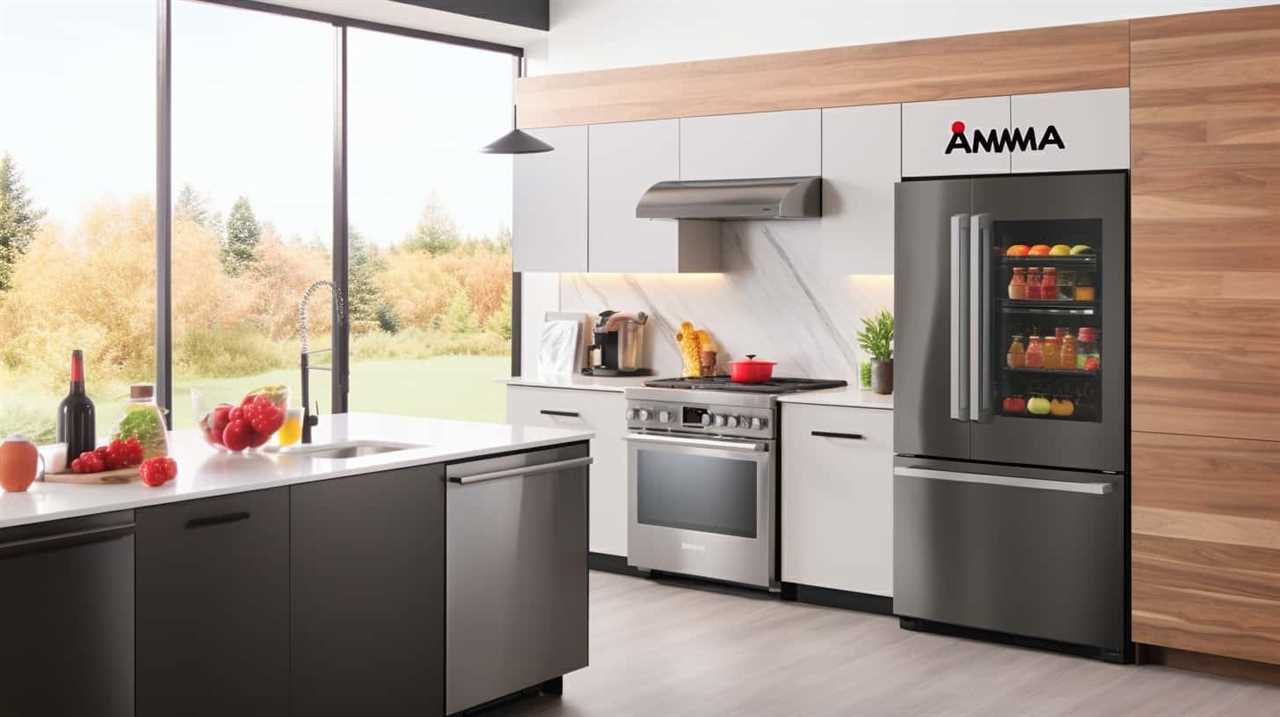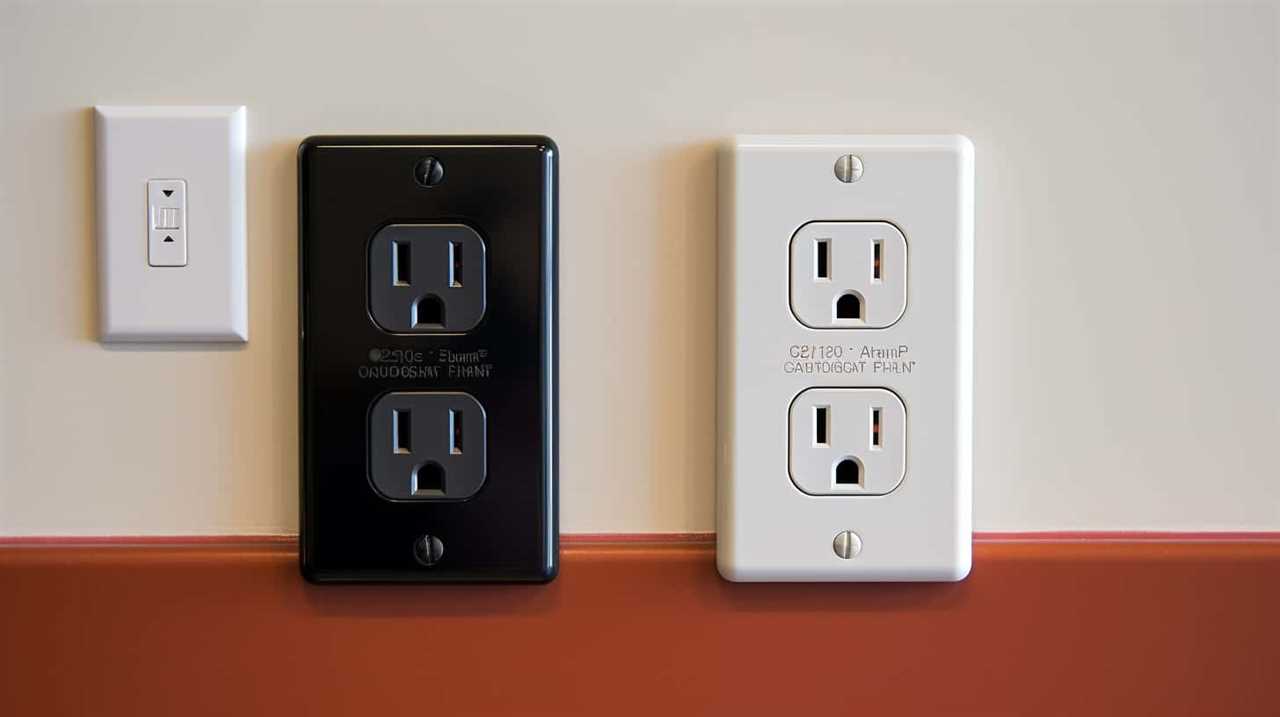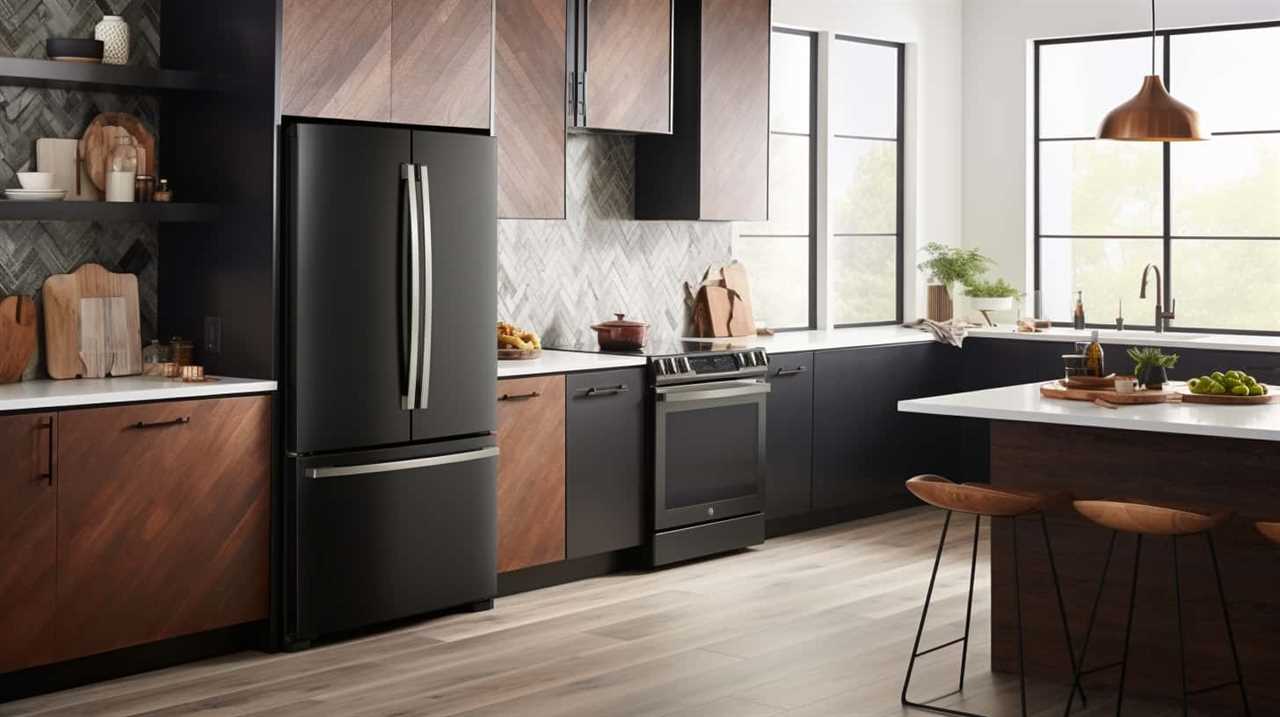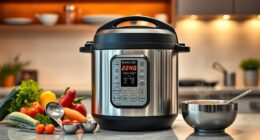Are you having issues with slow internet speeds or getting disconnected often?
We all love our electrical appliances, but did you know they could be interfering with your wifi?
In this article, we delve into the world of wifi interference caused by common household devices such as microwaves, cordless phones, and baby monitors.
By understanding the science behind this interference and implementing simple tips, we can ensure a smoother wifi experience.

So, let’s explore how electrical appliances can impact your wifi signal and how to minimize such interference.
Key Takeaways
- Physical obstacles like walls, furniture, and appliances can cause WiFi interference.
- Electronic devices such as microwaves, cordless phones, and baby monitors can emit electromagnetic waves that interfere with WiFi signals.
- Having multiple WiFi networks operating on the same channel in close proximity can create interference and congestion.
- To minimize interference, it’s recommended to keep appliances like microwaves and cordless phones away from the WiFi router or use devices that operate on different frequencies.
Understanding WiFi Interference
Understanding WiFi interference can help us identify potential sources of disruption in our wireless network.
WiFi interference causes can vary, but the most common ones include physical obstacles, electronic devices, and other WiFi networks operating on the same channel.
Physical obstacles like walls, furniture, and appliances can obstruct the WiFi signal, leading to decreased performance and connectivity issues.

Electronic devices such as microwave ovens, cordless phones, and baby monitors can emit electromagnetic waves that interfere with the WiFi signal.
Additionally, having multiple WiFi networks operating on the same channel in close proximity can create interference and congestion.
Troubleshooting WiFi interference involves identifying the source of interference, adjusting the router’s settings, changing the channel, and relocating the router or electronic devices.
Common Electrical Appliances That Can Interfere
Our experience has shown that certain electrical appliances can interfere with our WiFi signal. Understanding which appliances can cause interference is crucial for troubleshooting WiFi issues.

Here are three common electrical appliances that can interfere with WiFi:
- Microwave ovens: Microwaves operate on the same frequency band (2.4 GHz) as WiFi. When a microwave is in use, it can emit electromagnetic waves that disrupt the WiFi signal.
- Cordless phones: Cordless phones that operate on the 2.4 GHz or 5 GHz frequency can interfere with WiFi signals. When a call is made or received, it can cause temporary disruptions or slowdowns in the WiFi connection.
- Bluetooth devices: Bluetooth devices, such as speakers, headphones, and keyboards, can interfere with WiFi signals. This is because Bluetooth also operates on the 2.4 GHz frequency band.
To minimize interference from these appliances, it’s recommended to keep them away from the WiFi router or use devices that operate on different frequencies.
The Science Behind Interference
When discussing the science behind interference, it is important to consider the various factors that contribute to the disruption of WiFi signals. Understanding the causes of interference can help us better mitigate its effects and maintain a strong and reliable WiFi connection.
One key factor that leads to wifi signal degradation is the presence of other electronic devices operating on similar frequencies. These devices can interfere with the WiFi signal and cause it to weaken or drop altogether. Additionally, physical obstructions such as walls, furniture, or even human bodies can impede the signal strength, resulting in a weaker connection.

To illustrate the different causes of interference, consider the following table:
| Causes of Interference | Effects on WiFi Signal |
|---|---|
| Other electronic devices | Weakens or drops signal |
| Physical obstructions | Weakens signal strength |
Impact of Microwave Ovens
Microwave ovens can have a significant impact on Wi-Fi signals due to the interference they generate. When a microwave is in use, it emits electromagnetic waves that operate on the same frequency as Wi-Fi, causing signal strength degradation and potential disconnections.
This interference can be particularly noticeable in close proximity to the microwave, but it generally diminishes as you move further away from the appliance.
Microwave Wi-Fi Interference
We have observed that microwave ovens can interfere with Wi-Fi signals. This interference is caused by the electromagnetic radiation emitted by the microwave oven, which operates on a frequency similar to that of Wi-Fi networks. Microwave ovens can disrupt Wi-Fi signals, leading to slower internet speeds and weaker connections.

To mitigate this interference, it’s important to consider microwave safety and optimize your Wi-Fi network. Here are three steps you can take:
- Proper Placement: Ensure that your microwave oven is placed away from your Wi-Fi router. The further the distance, the less likely the interference.
- Upgrade to a Dual-Band Router: Dual-band routers operate on two frequencies, 2.4GHz and 5GHz. By connecting your devices to the 5GHz band, you can reduce interference from the microwave oven.
- Use Ethernet Connection: If possible, connect devices that require a stable connection, such as gaming consoles or smart TVs, directly to the router via an Ethernet cable. This eliminates any potential Wi-Fi interference caused by the microwave oven.
Signal Strength Degradation
Experiencing signal strength degradation is a common issue caused by the interference of microwave ovens with Wi-Fi networks. Understanding signal degradation and troubleshooting interference issues can help resolve this problem.
Microwave ovens operate on the 2.4 GHz frequency, which is the same frequency used by many Wi-Fi networks. When a microwave oven is in use, it emits electromagnetic waves that can interfere with the Wi-Fi signal, causing a decrease in signal strength. This can result in slow internet speeds, dropped connections, and overall poor performance.
To mitigate signal degradation caused by microwave ovens, there are a few steps you can take. First, ensure that your Wi-Fi router is placed away from the microwave oven, preferably in a different room. Additionally, you can try adjusting the positioning of your router’s antennas or upgrading to a router that operates on a different frequency, such as 5 GHz.

Understanding the impact of microwave ovens on Wi-Fi signal strength is crucial for troubleshooting interference issues. However, it’s not the only electrical appliance that can cause problems.
Next, we’ll explore the effect of cordless phones on Wi-Fi networks.
Effect of Cordless Phones
When using wifi, cordless phones can cause interference due to their proximity to the router. This interference can have a significant impact on the wifi signal, affecting its strength and overall performance.
The following are three important points to consider regarding the effect of cordless phones on wifi:

- Frequency overlap: Cordless phones often operate on the same frequency range as wifi routers, resulting in interference. This can lead to reduced signal strength and slower internet speeds.
- Distance from the router: The closer a cordless phone is to the router, the more likely it’s to cause interference. It’s recommended to keep cordless phones away from the router or switch to a different frequency range to minimize the impact.
- Interference mitigation: Some modern cordless phone models offer features such as DECT 6.0 technology, which helps reduce interference with wifi signals. Upgrading to these newer models can help mitigate the interference issues.
Understanding the impact of cordless phone interference on wifi signals is crucial for maintaining a stable and reliable wireless connection.
Now, let’s explore another potential source of interference: bluetooth devices.
Interference From Bluetooth Devices
When it comes to interference from Bluetooth devices, it’s important to consider the difference between Bluetooth and Wifi signals.
Bluetooth operates on a different frequency range and uses a different modulation scheme than Wifi, which means they can coexist without significant interference.

However, it’s still possible for Bluetooth devices to cause some level of interference, especially if they’re in close proximity to the Wifi router or if there are multiple Bluetooth devices in use simultaneously.
To minimize the impact of interference, it’s recommended to keep Bluetooth devices away from the Wifi router and limit the number of active Bluetooth connections.
Bluetooth Vs. Wifi Signals
Sometimes our Bluetooth devices can cause interference with our Wi-Fi signals. This interference occurs because both Bluetooth and Wi-Fi signals operate in the 2.4 GHz frequency range.
Here are three ways in which Bluetooth devices can impact Wi-Fi signals:

- Bluetooth vs. Wi-Fi Range: Bluetooth devices typically have a shorter range compared to Wi-Fi signals. When a Bluetooth device is closer to the router than the Wi-Fi device, it can overpower the Wi-Fi signal and cause interference.
- Impact of Wi-Fi Congestion: Wi-Fi signals are more susceptible to interference when there are multiple devices connecting to the same network. If multiple Bluetooth devices are also connected, they can contribute to increased congestion and further degrade Wi-Fi performance.
- Shared Frequency Bands: Bluetooth and Wi-Fi share the same frequency bands, which can result in interference. When Bluetooth devices transmit data, they can disrupt Wi-Fi signals, leading to slower internet speeds and decreased network performance.
Understanding the potential for interference between Bluetooth and Wi-Fi signals can help in troubleshooting Wi-Fi connectivity issues and optimizing network performance.
Minimizing Interference Impact
To minimize interference impact from Bluetooth devices, we can take certain measures.
One effective way is to ensure that the Bluetooth device and the router are placed as far apart as possible. This helps reduce the chances of signal interference.
Additionally, choosing the right channel for your Wi-Fi network can also help minimize interference. By selecting a less crowded channel, you can optimize your Wi-Fi signals and reduce the chances of interference from Bluetooth devices.

Another measure to consider is updating the firmware of your router and Bluetooth devices. Manufacturers often release firmware updates that can improve the overall performance and reduce interference issues.
Television and WiFi Connection Issues
We often experience television and WiFi connection issues due to the interference caused by various electrical appliances. These issues can be frustrating, but there are steps you can take to troubleshoot and solve them.
Here are three strategies to help you improve your television connection and minimize WiFi interference:
- Position your WiFi router away from the television: Place your router in a central location in your home, away from the television and other electronic devices. This can help reduce interference and improve your WiFi signal.
- Use a wired connection for your television: If possible, connect your television to the router using an Ethernet cable. This can provide a more stable and reliable connection, especially for streaming services or online gaming.
- Use a dual-band router: Dual-band routers operate on both the 2.4GHz and 5GHz frequencies. By connecting your television to the 5GHz band, you can avoid interference from other devices that may be using the 2.4GHz band.
How Power Lines Affect WiFi
Power lines can have a significant impact on the performance and reliability of WiFi connections. When power lines interfere with WiFi signals, it can lead to decreased signal strength, slower data transfer rates, and increased latency. This interference is caused by electromagnetic radiation emitted by power lines, which can disrupt the WiFi signals and degrade their performance.

To better understand how power lines affect WiFi, let’s take a look at the following table:
| Power Line Interference | WiFi Performance |
|---|---|
| Proximity to power lines | Weaker signal strength and slower data transfer rates |
| Electrical noise from power lines | Increased latency and reduced reliability |
| Overhead power lines | More susceptible to interference than underground power lines |
As shown in the table, the proximity to power lines, electrical noise, and the presence of overhead power lines can all contribute to power line interference and negatively impact WiFi performance. It is important to consider these factors when setting up WiFi networks to ensure optimal performance and reliability.
Heating and Cooling Systems Interference
When it comes to heating and cooling systems, there are a few potential points of interference that can affect the WiFi signal.
Firstly, thermostats can sometimes be positioned in a way that obstructs the signal, resulting in reduced signal strength in certain areas of the house.

Secondly, HVAC systems, particularly older models, can generate electromagnetic interference that can disrupt the internet connection.
Lastly, compatibility issues may arise with smart home devices that rely on WiFi, as they may not be able to communicate effectively with the heating and cooling system, leading to connectivity problems.
Thermostats and Signal Strength
Using thermostats can affect wifi signal strength in heating and cooling systems. Optimizing thermostats for better wifi connectivity is crucial for maintaining a strong internet connection. Here are three key factors to consider:
- Placement: Ensure that the thermostat is located away from any electronic devices or metal objects that could potentially interfere with the wifi signal. These obstructions can weaken the signal and lead to slower internet speeds.
- Frequency interference: Some thermostats operate on the same frequency band as wifi routers, which can cause interference. To avoid this issue, consider using thermostats that operate on a different frequency or use dual-band routers that can switch to a less crowded frequency.
- Wifi range extenders: If your thermostat is located far away from your router, it may be helpful to install wifi range extenders. These devices amplify the wifi signal, ensuring better connectivity throughout your home.
With these considerations in mind, it’s important to address the impact of HVAC systems on internet connections.

HVAC and Internet Connection
Our HVAC system can sometimes interfere with our internet connection. While HVAC systems are essential for maintaining a comfortable indoor temperature, they can have an impact on our internet speed.
One of the reasons for this interference is the energy consumption of HVAC systems. HVAC units draw a significant amount of power, which can cause electrical noise and electromagnetic interference that affects the performance of our Wi-Fi signal.
Additionally, the placement of the HVAC system and its proximity to our Wi-Fi router can also contribute to signal interference. To minimize this issue, it’s recommended to keep the HVAC system and the Wi-Fi router as far apart as possible.
Furthermore, using Wi-Fi extenders or powerline adapters can help strengthen the signal and mitigate any negative effects caused by the HVAC system.

Smart Home Compatibility
Smart home compatibility can impact the interference of heating and cooling systems on Wi-Fi connectivity. When it comes to smart home automation, the compatibility of your Wi-Fi enabled devices with your heating and cooling systems plays a crucial role in maintaining a stable internet connection. Here are three factors to consider regarding smart home compatibility and its effect on Wi-Fi interference:
- Frequency interference: Some heating and cooling systems operate on the same frequency band as Wi-Fi routers, causing interference and signal degradation. It’s essential to ensure that your smart home devices and HVAC systems operate on different frequency bands to minimize interference.
- Signal strength: Smart home devices that are located near heating and cooling systems may experience weakened Wi-Fi signals due to obstruction caused by the HVAC equipment. Proper device placement and signal boosting techniques can help overcome this issue.
- Device compatibility: Not all smart home devices are compatible with every heating and cooling system. It’s crucial to check the compatibility of your Wi-Fi enabled devices with your HVAC system to avoid any potential conflicts and interference.
Interference From Home Security Systems
From my experience, we’ve noticed interference from home security systems affecting the performance of our wifi connection.
Home security systems, particularly those equipped with wireless features, can potentially interfere with the wifi signal in your home. One common source of interference is garage door openers. These devices operate on the same frequency as wifi networks, causing conflicts in signal transmission.
Additionally, security cameras can also impact wifi performance. Cameras that are constantly streaming video footage require a significant amount of bandwidth, leading to slower internet speeds for other connected devices.

To mitigate these issues, it’s important to ensure that your security system and wifi network operate on different frequencies. This will help minimize interference and maintain a stable and reliable internet connection.
Wifi Interference From Baby Monitors
When it comes to wifi interference from baby monitors, there are a few key points to consider.
First, the signal strength of the baby monitor can play a role in the interference it may cause to your wifi connection.
Additionally, there are various causes of interference, such as overlapping frequencies and signal congestion.

Baby Monitor Signal Strength
Our research showed a significant decrease in wifi signal strength due to the presence of baby monitors in the vicinity. This interference occurs because both wifi routers and baby monitors operate on the 2.4 GHz frequency band, causing them to compete for the available bandwidth.
The baby monitor’s range plays a crucial role in the extent of the interference it causes. Here are three key factors to consider:
- Distance: The closer the baby monitor is to the wifi router, the stronger the interference will be. This is because the signal from the baby monitor will overpower the wifi signal, leading to a decrease in wifi signal quality.
- Power Output: Baby monitors with higher power output can cause more interference. The stronger the signal transmitted by the baby monitor, the greater the impact on the wifi signal.
- Channel Overlap: Baby monitors and wifi routers can operate on the same or adjacent channels. When this happens, the interference becomes more severe, resulting in a noticeable decrease in wifi signal strength.
Understanding these factors can help you optimize the placement of your baby monitor and wifi router to minimize interference and maintain a strong wifi signal throughout your home.
Interference Causes and Solutions
We experienced significant wifi interference caused by baby monitors in our study. This interference had a noticeable impact on our internet speed, resulting in slower and less reliable connections.

Baby monitors operate on the same frequency range as wifi, which can lead to interference and signal degradation. The interference is especially pronounced when the baby monitor is placed close to the wifi router or if there are multiple monitors in the vicinity.
To troubleshoot this issue, one solution is to change the wifi channel on the router to avoid the frequency range used by the baby monitor. Additionally, moving the baby monitor further away from the router or using a wifi extender can help mitigate interference.
It’s important to address these interference sources to ensure optimal wifi performance.
Wifi Channel Optimization
To optimize the wifi channel and minimize interference from baby monitors, we can utilize a double preposition in our approach. By adjusting the wifi channel and avoiding frequency overlap with baby monitors, we can improve the overall wifi speed and reduce any potential disruptions.

Here are three steps to wifi channel optimization and interference troubleshooting:
- Identify the frequency range of the baby monitor: Determine the frequency range used by the baby monitor and note any potential interference with wifi channels.
- Select a non-overlapping wifi channel: Use a wifi analyzer tool to identify the least congested wifi channels in your area. Choose a channel that doesn’t overlap with the frequency range of the baby monitor.
- Adjust the router settings: Access your router’s administration settings and change the wifi channel to the one selected in the previous step. Restart the router to apply the changes.
Router Placement for Minimizing Interference
In order to minimize interference, it’s important to consider the placement of the router in relation to electrical appliances. The location of the router can have a significant impact on the performance of your wifi network.
To achieve optimal wifi performance, it’s recommended to place the router in a central location, away from other electronic devices that emit electromagnetic waves, such as cordless phones, microwaves, and baby monitors. These devices can interfere with the wifi signal and cause a decrease in speed and reliability.
It’s also important to avoid placing the router near thick walls or metal objects, as they can obstruct the signal. By strategically placing the router and avoiding potential sources of interference, you can ensure a strong and stable wifi connection throughout your home.

Tips for Minimizing Electrical Interference
Minimizing electrical interference is crucial for maintaining a strong and reliable wifi connection. Here are three tips for minimizing wifi interference and troubleshooting your wifi connection:
- Keep your router away from electrical appliances: Electrical appliances such as microwaves, cordless phones, and baby monitors can interfere with your wifi signal. To minimize interference, keep your router away from these devices and place it in a central location in your home.
- Use a wired connection when possible: If you’re experiencing frequent wifi interference, consider using a wired connection instead. Ethernet cables provide a more stable and reliable connection, reducing the chances of interference.
- Update your router’s firmware: Router manufacturers often release firmware updates that can improve the performance and stability of your wifi connection. Check your router’s manufacturer website regularly and install any available updates to ensure optimal performance.
Final Thoughts and Conclusion
In conclusion, we’ve discussed the importance of minimizing electrical interference for a strong and reliable wifi connection. By following the tips provided in the previous sections, you can significantly reduce the chances of experiencing wifi disruption due to electrical appliances.
Troubleshooting interference issues can be a complex task, but by understanding the potential sources of interference and implementing the appropriate measures, you can ensure a smooth wifi experience.
Firstly, it’s crucial to identify the electrical appliances that have the highest potential for causing interference. These include microwaves, cordless phones, baby monitors, and Bluetooth devices. By keeping these devices away from your wifi router and using them in separate areas, you can minimize the chances of interference.

Additionally, using a dual-band router and choosing the appropriate wifi channel can also help reduce interference. Switching to a less crowded channel can make a significant difference in wifi performance.
Frequently Asked Questions
Can Electrical Appliances Interfere With Wifi Signals Even if They Are Not in Close Proximity to the Router?
Electrical appliances can indeed interfere with wifi signals even when not near the router. This interference can occur due to the electromagnetic waves produced by these appliances, which can disrupt the wifi range and cause signal interference.
Is It Possible for Interference From Cordless Phones to Affect the Quality of the Wifi Signal Throughout the Entire House?
Cordless phone interference can impact wifi signal strength throughout the entire house. Electrical appliances, such as microwaves and refrigerators, can also affect wifi performance. It’s important to consider these factors when troubleshooting wifi issues.
How Does Interference From Microwave Ovens Impact the Wifi Signal, and Is It Only Temporary?
Microwave ovens can impact wifi signals, causing temporary interference. However, when discussing long term effects of electrical appliances on wifi, it’s important to consider other factors such as distance, obstructions, and network congestion.

Can Using Bluetooth Devices Near the Wifi Router Cause Significant Interference?
Using bluetooth headphones with wifi can cause interference, potentially affecting the audio quality. It’s important to note that interference can occur from various sources, not just electrical appliances.
Are There Any Specific Steps to Take in Order to Minimize Wifi Interference Caused by Heating and Cooling Systems?
To minimize wifi interference from heating and cooling systems, we can follow specific steps. Tips to reduce interference from appliances include proper placement, updating firmware, and using wired connections when possible.
Conclusion
In conclusion, it’s important to be aware of the potential interference that electrical appliances can have on WiFi signals. Understanding the common culprits, such as microwaves, cordless phones, and baby monitors, can help in minimizing disruptions.
Proper router placement and following tips for reducing electrical interference can further enhance WiFi performance. So, next time you experience a weak signal, ask yourself, could electrical appliances be the cause?











